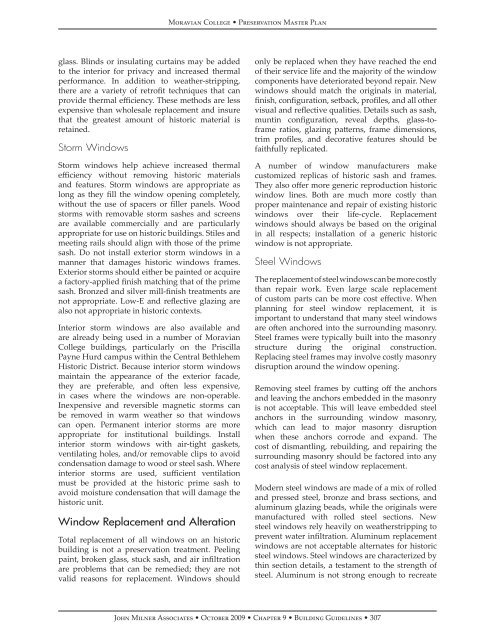Moravian Preservation Master Plan.indb - Society for College and ...
Moravian Preservation Master Plan.indb - Society for College and ...
Moravian Preservation Master Plan.indb - Society for College and ...
Create successful ePaper yourself
Turn your PDF publications into a flip-book with our unique Google optimized e-Paper software.
<strong>Moravian</strong> <strong>College</strong> • <strong>Preservation</strong> <strong>Master</strong> <strong>Plan</strong><br />
glass. Blinds or insulating curtains may be added<br />
to the interior <strong>for</strong> privacy <strong>and</strong> increased thermal<br />
per<strong>for</strong>mance. In addition to weather-stripping,<br />
there are a variety of retrofit techniques that can<br />
provide thermal efficiency. These methods are less<br />
expensive than wholesale replacement <strong>and</strong> insure<br />
that the greatest amount of historic material is<br />
retained.<br />
Storm Windows<br />
Storm windows help achieve increased thermal<br />
efficiency without removing historic materials<br />
<strong>and</strong> features. Storm windows are appropriate as<br />
long as they fill the window opening completely,<br />
without the use of spacers or filler panels. Wood<br />
storms with removable storm sashes <strong>and</strong> screens<br />
are available commercially <strong>and</strong> are particularly<br />
appropriate <strong>for</strong> use on historic buildings. Stiles <strong>and</strong><br />
meeting rails should align with those of the prime<br />
sash. Do not install exterior storm windows in a<br />
manner that damages historic windows frames.<br />
Exterior storms should either be painted or acquire<br />
a factory-applied finish matching that of the prime<br />
sash. Bronzed <strong>and</strong> silver mill-finish treatments are<br />
not appropriate. Low-E <strong>and</strong> reflective glazing are<br />
also not appropriate in historic contexts.<br />
Interior storm windows are also available <strong>and</strong><br />
are already being used in a number of <strong>Moravian</strong><br />
<strong>College</strong> buildings, particularly on the Priscilla<br />
Payne Hurd campus within the Central Bethlehem<br />
Historic District. Because interior storm windows<br />
maintain the appearance of the exterior facade,<br />
they are preferable, <strong>and</strong> often less expensive,<br />
in cases where the windows are non-operable.<br />
Inexpensive <strong>and</strong> reversible magnetic storms can<br />
be removed in warm weather so that windows<br />
can open. Permanent interior storms are more<br />
appropriate <strong>for</strong> institutional buildings. Install<br />
interior storm windows with air-tight gaskets,<br />
ventilating holes, <strong>and</strong>/or removable clips to avoid<br />
condensation damage to wood or steel sash. Where<br />
interior storms are used, sufficient ventilation<br />
must be provided at the historic prime sash to<br />
avoid moisture condensation that will damage the<br />
historic unit.<br />
Window Replacement <strong>and</strong> Alteration<br />
Total replacement of all windows on an historic<br />
building is not a preservation treatment. Peeling<br />
paint, broken glass, stuck sash, <strong>and</strong> air infiltration<br />
are problems that can be remedied; they are not<br />
valid reasons <strong>for</strong> replacement. Windows should<br />
only be replaced when they have reached the end<br />
of their service life <strong>and</strong> the majority of the window<br />
components have deteriorated beyond repair. New<br />
windows should match the originals in material,<br />
finish, configuration, setback, profiles, <strong>and</strong> all other<br />
visual <strong>and</strong> reflective qualities. Details such as sash,<br />
muntin configuration, reveal depths, glass-toframe<br />
ratios, glazing patterns, frame dimensions,<br />
trim profiles, <strong>and</strong> decorative features should be<br />
faithfully replicated.<br />
A number of window manufacturers make<br />
customized replicas of historic sash <strong>and</strong> frames.<br />
They also offer more generic reproduction historic<br />
window lines. Both are much more costly than<br />
proper maintenance <strong>and</strong> repair of existing historic<br />
windows over their life-cycle. Replacement<br />
windows should always be based on the original<br />
in all respects; installation of a generic historic<br />
window is not appropriate.<br />
Steel Windows<br />
The replacement of steel windows can be more costly<br />
than repair work. Even large scale replacement<br />
of custom parts can be more cost effective. When<br />
planning <strong>for</strong> steel window replacement, it is<br />
important to underst<strong>and</strong> that many steel windows<br />
are often anchored into the surrounding masonry.<br />
Steel frames were typically built into the masonry<br />
structure during the original construction.<br />
Replacing steel frames may involve costly masonry<br />
disruption around the window opening.<br />
Removing steel frames by cutting off the anchors<br />
<strong>and</strong> leaving the anchors embedded in the masonry<br />
is not acceptable. This will leave embedded steel<br />
anchors in the surrounding window masonry,<br />
which can lead to major masonry disruption<br />
when these anchors corrode <strong>and</strong> exp<strong>and</strong>. The<br />
cost of dismantling, rebuilding, <strong>and</strong> repairing the<br />
surrounding masonry should be factored into any<br />
cost analysis of steel window replacement.<br />
Modern steel windows are made of a mix of rolled<br />
<strong>and</strong> pressed steel, bronze <strong>and</strong> brass sections, <strong>and</strong><br />
aluminum glazing beads, while the originals were<br />
manufactured with rolled steel sections. New<br />
steel windows rely heavily on weatherstripping to<br />
prevent water infiltration. Aluminum replacement<br />
windows are not acceptable alternates <strong>for</strong> historic<br />
steel windows. Steel windows are characterized by<br />
thin section details, a testament to the strength of<br />
steel. Aluminum is not strong enough to recreate<br />
John Milner Associates • October 2009 • Chapter 9 • Building Guidelines • 307

















